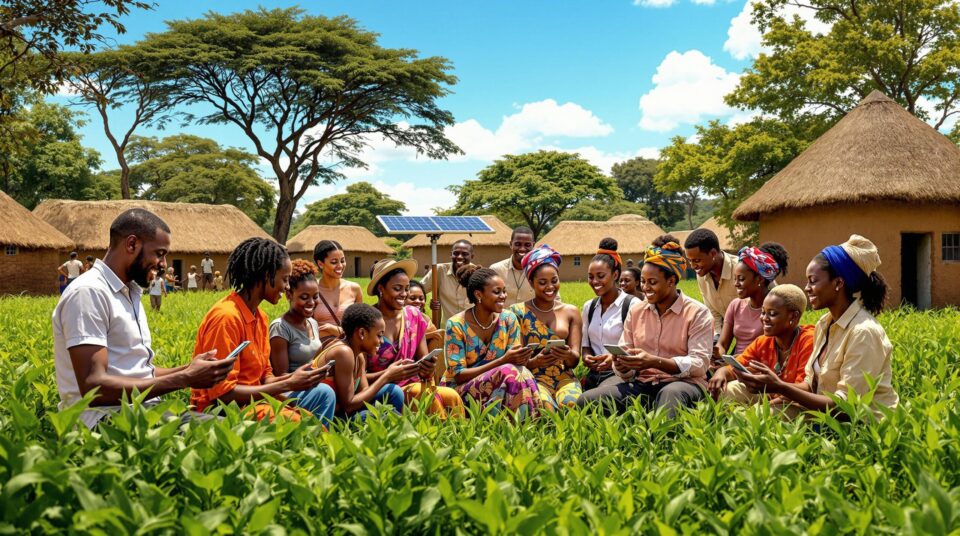Africa is bridging the digital divide in rural areas through partnerships between governments and private companies. These collaborations are expanding internet access, improving education, healthcare, and agriculture, and empowering communities. Here’s a quick look at the top-performing countries:
- Kenya: Solar-powered towers, TV White Space, and digital literacy programs.
- Rwanda: Satellite internet, fiber optics, and solar-powered hubs.
- South Africa: SA Connect program, solar Wi-Fi towers, and local entrepreneur-led digital literacy.
- Ghana: Rural Telephony Project with Huawei and MTN, using satellite and solar tech.
- Nigeria: Solar base stations, community networks, and tailored rural solutions.
- Uganda: Solar-powered systems and wireless technologies for remote areas.
- Morocco: Government-private partnerships addressing specific geographical needs.
Quick Comparison
| Country | Key Technologies/Initiatives | Challenges Addressed |
|---|---|---|
| Kenya | Solar towers, TV White Space, LEO satellites | Connectivity in remote areas |
| Rwanda | Satellite internet, fiber optics, solar hubs | Cost and terrain limitations |
| South Africa | SA Connect, solar Wi-Fi, local literacy | Digital divide in rural areas |
| Ghana | TV White Space, solar towers, satellite | Infrastructure and access gaps |
| Nigeria | Solar base stations, community networks | Affordability and maintenance |
| Uganda | Solar-powered systems, wireless tech | Limited electricity and terrain |
| Morocco | PPPs, rural-specific programs | Geographical barriers |
Zenzeleni project provides internet services to rural South Africa

How Countries Were Selected
We evaluated four key areas to determine the top-performing countries:
- PPP success: This included factors like meeting project deadlines, achieving connectivity goals, securing sustainable funding, and involving local communities.
- Rural coverage growth: We looked at the percentage increase in connectivity, the number of new households connected, improvements in speed and reliability, and cost efficiency.
- Program longevity: This focused on the consistency and scalability of initiatives over time.
- Use of advanced technology: Examples include solar-powered base stations, TV White Space, LEO satellites, and mesh networks.
Each area was weighted to balance immediate results with long-term benefits. This comprehensive approach helped us identify seven countries that excel in using public-private partnerships to expand rural connectivity.
1. Kenya
Kenya has made strides in improving internet access in rural areas through partnerships between the government and private companies. These efforts focus on overcoming connectivity challenges in underserved regions, with programs like the Universal Service Fund bringing high-speed internet to remote communities.
One key area of focus is improving digital literacy in rural schools by ensuring they have reliable internet access. Technology companies have also played a role by using TV White Space technology to expand network coverage. Additionally, solutions like solar-powered base stations, mesh networks, and LEO satellite links have been implemented to extend connectivity across Kenya’s rural regions.
2. Rwanda
Rwanda has made impressive progress in bringing internet access to rural areas through public-private partnerships (PPPs). The “Internet for All” initiative has played a major role in bridging the gap between urban and rural connectivity by extending internet access to remote communities.
The Rwanda Information Communication Technology Authority (RICT) teamed up with MTN Rwanda and Airtel Rwanda to improve rural coverage. This collaboration has led to the installation of new cell towers in remote areas, which has helped lower internet costs for rural users.
In partnership with Starlink, Rwanda has introduced satellite internet to mountainous regions that were previously out of reach. This has allowed remote schools and healthcare centers to gain access to fast internet, enhancing education and healthcare services. This partnership has also paved the way for additional local infrastructure projects.
Several key efforts have contributed to these advancements, including:
- Setting up solar-powered internet hubs
- Launching a digital ambassador program
- Expanding rural broadband with fiber optic technology
These projects have improved internet adoption rates, download speeds, and access to essential services in rural areas.
Rwanda’s Minister of ICT and Innovation recently shared the impact of these efforts, saying:
“Through our partnership model, we’ve not only expanded coverage but created sustainable digital ecosystems in rural communities. The focus now is on leveraging this infrastructure for economic growth and education.”
Additionally, KivuWatt Technologies has introduced solar-powered mesh networks, providing reliable internet access in rural communities where traditional infrastructure has been difficult to implement.
3. South Africa
South Africa is making strides in expanding internet access to rural areas through partnerships between the government and private sector. The SA Connect program, in collaboration with major telecom companies, plays a key role in bringing broadband to remote communities. This initiative opens the door for more government-led projects aimed at improving connectivity.
Government agencies team up with tech firms to roll out high-speed internet in underserved regions. The Department of Communications and Digital Technologies prioritizes connecting schools and healthcare facilities, addressing gaps in traditional infrastructure and promoting digital access in these areas.
To reach these communities, the Universal Service and Access Agency uses a mix of technologies, including TV white space, solar-powered Wi-Fi towers, and satellite internet. This approach ensures connectivity even in the most remote locations.
Beyond the technical solutions, local entrepreneurs are stepping up to boost digital literacy. These efforts not only improve access to critical online services but also create new economic opportunities in rural areas. Together, these initiatives are helping bridge the digital divide across South Africa.
4. Ghana
Ghana addresses rural connectivity challenges through partnerships between the public and private sectors. The Ghana Investment Fund for Electronic Communications (GIFEC) spearheads the Rural Telephony Project, working with major tech companies like Huawei and MTN Ghana to expand network coverage in remote areas.
To tackle infrastructure issues, Ghana employs technologies such as TV White Space, solar-powered towers, and satellite internet. These efforts aim to improve connectivity while supporting education, healthcare, and economic development. These advancements are helping to introduce new internet technologies to rural communities in Africa.
sbb-itb-dd089af
5. Nigeria
Nigeria is making progress in connecting rural areas through public-private partnerships. These collaborations are using innovative solutions like solar-powered base stations and community networks to bring internet access to remote regions. This expanded access is opening doors for improvements in education, healthcare, and local economies.
For example, these projects have connected rural schools, healthcare centers, and small businesses, enabling remote learning, telemedicine, and new economic opportunities. Such efforts align with similar initiatives seen in other countries, but Nigeria is tailoring its approach to meet the unique needs of its rural areas.
However, challenges persist. Maintaining infrastructure across Nigeria’s vast rural landscape and keeping services affordable for low-income communities remain significant hurdles. To address these issues, authorities are looking into long-term investments and community-led solutions to ensure both sustainability and affordability.
Nigeria’s focus on collaboration and digital access is helping drive economic development and improve quality of life in underserved areas.
6. Uganda
Uganda has improved rural internet connectivity by working closely with both national regulators and private companies. These partnerships have expanded network coverage to areas that were previously hard to reach, using a mix of fixed-line and wireless technologies.
To tackle the challenge of limited electricity in rural areas, solar-powered systems have been introduced. These efforts are helping to bring digital access to more people across the country.
However, maintaining infrastructure and ensuring reliable service remain ongoing challenges. Uganda continues to explore new technologies and partnerships to enhance rural connectivity, paving the way for future advancements in internet access.
7. Morocco
Morocco is making strides in bridging the digital divide through a collaborative effort between government bodies and private companies. A key example is its rural connectivity program, developed through public-private partnerships with major players like Maroc Telecom. This initiative takes inspiration from other African successes while addressing Morocco’s specific geographical needs.
New Internet Technologies in Use
Public-private partnership (PPP) models have already shown success in boosting internet access across several African countries. Now, new internet technologies are stepping in to speed up connectivity, especially in remote areas where traditional infrastructure faces challenges. Satellite and laser-based solutions are playing a key role in these efforts.
For instance, Starlink’s low-earth orbit satellites provide high-speed internet in places where conventional systems can’t reach. Similarly, Google’s Project Taara uses laser communication to transmit data over long distances, cutting out the need for fiber optic cables.
Current Problems and Growth Areas
Rural internet access in Africa faces several tough challenges, with high infrastructure costs in remote areas being one of the biggest hurdles.
Infrastructure and Terrain Challenges
Geography plays a major role in complicating internet deployment. Mountain ranges, dense forests, and scattered rural communities make setting up and maintaining network infrastructure a technical and logistical challenge.
Regulatory Framework Issues
Outdated policies are another barrier. Issues like limited spectrum allocation, slow licensing processes, minimal infrastructure sharing, and cross-border connectivity problems significantly slow down progress.
Opportunities for Growth
Despite these obstacles, there are promising ways to address rural internet access challenges:
- New Funding Models: Combining government support with private investment can help lower the overall costs of building infrastructure.
- Advanced Technologies: Solutions like low Earth orbit satellites, solar-powered base stations, and mesh networking offer ways to bypass geographical limitations.
- Policy Updates: Recent regulatory reforms show how modern policies can speed up rural internet deployment.
Next Steps
Boost rural connectivity with practical and immediate actions. By building on current progress, these steps can help achieve even greater reach.
Technology Integration Strategy
Combine satellite broadband with existing land-based networks to improve internet access in remote rural regions.
Long-Term Funding Approaches
Use creative financing methods to ensure lasting connectivity. Blended funding – where public investments pair with private sector contributions, such as matching funds – can help keep rural internet initiatives both affordable and sustainable.
Policy Framework Adjustments
Revise regulations to speed up network rollouts. In various African countries, measures like infrastructure sharing mandates, simplified licensing, and tax incentives are helping reduce setup costs and accelerate project approvals.
Collaborate with local entrepreneurs and community leaders to maintain connectivity, ensuring services meet local needs and remain viable.
Focus on Technology Advancements
Emphasize renewable energy to cut costs, edge computing for localized data handling, and open RAN technology to enable scalable network growth.
These steps are key to expanding internet access across rural Africa.
